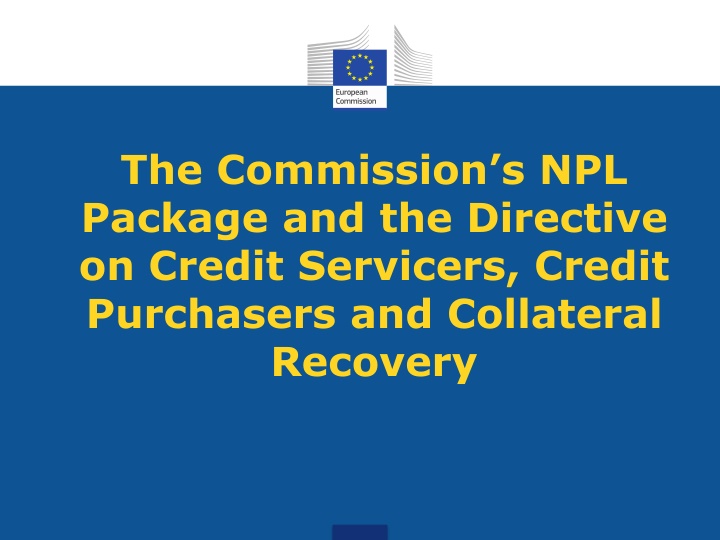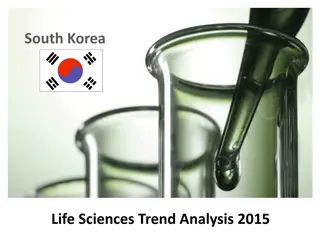
R&D in Korea: Workshop Insights
National Science and Technology Council Co-Chair, R&D intensity, expenditure, and activities in Korea are examined. Details on researchers, global cooperation, and the R&D budget for 2017 are also provided.
Download Presentation

Please find below an Image/Link to download the presentation.
The content on the website is provided AS IS for your information and personal use only. It may not be sold, licensed, or shared on other websites without obtaining consent from the author. If you encounter any issues during the download, it is possible that the publisher has removed the file from their server.
You are allowed to download the files provided on this website for personal or commercial use, subject to the condition that they are used lawfully. All files are the property of their respective owners.
The content on the website is provided AS IS for your information and personal use only. It may not be sold, licensed, or shared on other websites without obtaining consent from the author.
E N D
Presentation Transcript
The Commissions NPL Package and the Directive on Credit Servicers, Credit Purchasers and Collateral Recovery
Non-performing loans as impediment to bank lending and economic recovery Member States with high NPL had weaker bank lending (even when different GDP growth is accounted for) Banks with high NPL have difficulties to obtain capital and funding 2
NPLs: Declining but still high Non-performing loans (NPLs) are one of the remaining legacy risks in the European banking system. Despite the significant progress already made, NPLs continue to pose risks to economic growth and financial stability. Non-performing loans in the EU EU total gross non-performing loans and advances, in % of total gross loans and advances, end-of-quarter values 6 5 4 3 Mar 15 Mar 16 Mar 17 Mar 18 Sep 15 Sep 16 Sep 17 Dec 14 Dec 15 Dec 16 Dec 17 Jun 15 Jun 16 Jun 17 Source: European Central Bank 3
The Councils NPL Action Plan Mandates tasks to COM, EBA, ECA, ESRB and Member States Includes push and pull-factors. 4
The Commissions NPL package Based on the Council Action Plan to Tackle NPLs, the Commission put forward a comprehensive package of measures that will speed up thereduction of NPLs in Europe. It will create the appropriate environment for dealing with current NPLs and reduce the risk of future NPL accumulation. The proposed actions will enable banks and Member States to address NPLs in a more determined way than before. 5
Elements of the NPL package The package consists of two legislative proposals and a staff working document providing non-binding technical guidance (a so-called blueprint ) for how national Asset Management Companies (AMCs) can be set up by Member States, if they so wish. Together, these proposals will: o enhance the prudential tools needed to effectively address NPLs; o encourage the development of secondary markets for NPLs; o facilitate debt recovery by enhancing the protection of secured creditors in an extrajudicial proceeding; and o [assist Member States that so wish in the restructuring of their banks by establishing AMCs dealing with NPLs.] 5
Statutory prudential backstop What? Instrument: Measure to ensure sufficient loss coverage by banks for future NPLs A Regulation amending the Capital Requirements Regulation (CRR) Objective: To introduce common minimum coverage levels for newly originated loans that become non-performing. The minimum coverage levels will act as a statutory prudential backstop. The measure addresses the risk of not having enough money to cover losses on future NPLs and prevents their accumulation. 7
Secondary markets for NPLs: economic effects Development of NPL ratios in Member States with small or no loan sales vs Member States with loan sales 120 110 100 90 80 70 60 2014-Q4 2015-Q2 2015-Q4 2016-Q2 2016-Q4 2017-Q2 Weighted average MS with sales Weighted average MS with small/no sales 8
Content of the Directive What? Instrument: To improve the conditions for market entry for NPL buyers and loan servicing firms. Directive on credit servicers, credit purchasers and the recovery of collateral Objective: The proposal defines the activities of credit servicers, sets common standards for authorisation and supervision, and imposes conduct rules across the EU. As such, the proposal facilitates cross-border activities. The proposal does not affect contract law principles under national law Consumer protection is ensured by legal safeguards and transparency rules so that the transfer of a loan does not affect the rights and interest of the borrower. 9
Access to the European NPL market What changes? Safeguards for borrowers No authorisation for credit purchasers in any Member State but authorities are informed of the transfer. All legal protections applied to the bank loan remain in place. Proportionate supervision incentivises credit purchasers and servicers to treat borrowers fairly. Authorisation for credit servicers; can passport their services across the EU. Authorisation of credit servicers based on fit-and- proper criteria. Third-country purchasers of consumer loans to have them serviced by an authorised EU credit servicer or by a bank. Third-country purchasers to appoint a legal representative in the EU. 10
Collateral enforcement: economic effects 3.5 90 Time to recovery (years) Recovery rate (%) 80 3 70 2.5 60 2 50 40 1.5 30 1 20 0.5 10 0 0 Available Partially available Not available Available Partially available Not available Countries grouped by availability of extrajudicial procedures Countries grouped by availability of extrajudicial procedures 11
Accelerated extrajudicial collateral enforcement What? Instrument: Measure to provide more efficient value recovery from secured loans Directive on credit servicers, credit purchasers and the recovery of collateral Objective: To provide secured creditors with an efficient mechanism, based on and requiring upfront contractual agreement, for out-of-court value recovery from collateral. If the borrower defaults on the loan, such accelerated extrajudicial collateral enforcement will allow creditors to enforce the collateral securing the loan in an expedited way, without going to court. Strictly limited to loans granted to businesses: Consumer loans are excluded. Various safeguards for the borrower ensure a balanced mechanism. 12
Accelerated extrajudicial collateral enforcement: Safeguards Borrower can challenge the use of the mechanism in court; Consumer loans excluded; Excess proceeds to be turned over to the borrower; and Borrower s first residences excluded; Member States may put in place a rule that even where the proceeds from the collateral fall short of the amount outstanding on the loan, the loan shall be considered fully settled. Only upon upfront agreement between creditor and borrower; Rules on fair valuation; 13
A strong package with mutually reinforcing measures The proposalswould not be as effective if implemented in isolation 14
AMC Blueprint Instrument: What? Staff working document non-binding, non-legislative A technical guidance for how national AMCs can be set up Objective: To guide Member States on how they can set up national AMCs, should they find it useful, in full compliance with EU banking and State aid rules. Setting up an AMC is voluntary. While considering AMCs with a State aid element as an exceptional solution, the blueprint clarifies the permissible design of AMCs, if receiving public support. The blueprint suggests a number of common principles, on the set-up, governance and operations of AMCs. The blueprint draws on experience and best practices from AMCs already set up in Member States. 15
Conclusion NPLs are still an important challenge for the European banking system. The total volume of NPLs across the EU remains well above pre-crisis levels. Tackling this issue is supported by the economic recovery. Yet more is needed. The Commission therefore launched a comprehensive package of push and pull measures to address the NPL challenge. As Europe and its economy regain strength, we must seize the momentum and further reduce risks in the banking sector, accelerating the reduction of NPLs as well as preventing future build-ups of NPLs. 16






















